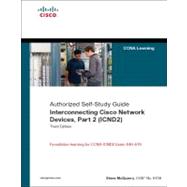
Note: Supplemental materials are not guaranteed with Rental or Used book purchases.
Purchase Benefits
What is included with this book?
Steve McQuerry, CCIE No. 6108, is a consulting systems engineer with Cisco focused on data center architecture. Steve works with enterprise customers in the Midwestern United States to help them plan their data center architectures. Steve has been an active member of the internetworking community since 1991 and has held multiple certifications from Novell, Microsoft, and Cisco. Before joining Cisco, Steve worked as an independent contractor with Global Knowledge, where he taught and developed coursework around Cisco technologies and certifications.
| Foreword | |
| ntroduction | |
| Review of Cisco IOS for Routers and Switches Chapter Objectives | p. 3 |
| Cisco IOS CLI Functions | p. 4 |
| Configuration Modes of Cisco IOS Software | p. 4 |
| Help Facilities of the Cisco IOS CLI | p. 6 |
| Commands Review 7 | |
| Summary of Cisco IOS CLI Commands 8 Chapter Summary 8 Review Questions | p. 8 |
| Medium-Sized Switched Network Construction Chapter Objectives | |
| Implementing VLANs and Trunks | |
| Understanding VLANs | |
| VLAN Overview | |
| Grouping Business Functions into VLANs | |
| Applying IP Address Space in the Enterprise Network | |
| Example: Network Design | |
| Considering Traffic Source to Destination Paths | |
| Voice VLAN Essentials | |
| VLAN Operation | |
| Understanding Trunking with 802.1Q | |
| 802.1Q Frame | |
| 802.1Q Native VLAN | |
| Understanding VLAN Trunking Protocol | |
| VTP Modes | |
| VTP Operation | |
| VTP Pruning | |
| Configuring VLANs and Trunks | |
| VTP Configuration | |
| Example: VTP Configuration | |
| 802.1Q Trunking Configuration | |
| VLAN Creation | |
| VLAN Port Assignment | |
| Adds, Moves, and Changes for VLANs | |
| Adding VLANs and Port Membership | |
| Changing VLANs and Port Membership | |
| Deleting VLANs and Port Membership | |
| Summary of Implementing VLANs and Trunks | |
| Improving Performance with Spanning Tree | |
| Building a Redundant Switched Topology | |
| Choosing Interconnection Technologies | |
| Determining Equipment and Cabling Needs | |
| EtherChannel Overview | |
| Redundant Topology | |
| Recognizing Issues of a Redundant Switched Topology | |
| Switch Behavior with Broadcast Frames | |
| Broadcast Storms | |
| Example: Broadcast Storms | |
| Multiple Frame Transmissions | |
| Example: Multiple Transmissions | |
| MAC Database Instability | |
| Resolving Issues with STP | |
| Spanning-Tree Operation | |
| Example: Selecting the Root Bridge | |
| Example: Spanning-Tree Operation | |
| Example: Spanning-Tree Path Cost | |
| Example: Spanning-Tree Recalculation | |
| STP Convergence | |
| Per VLAN Spanning Tree+ | |
| PVST+ Operation | |
| Rapid Spanning Tree Protocol | |
| Per VLAN RSTP | |
| Multiple Spanning Tree Protocol | |
| RSTP Port Roles | |
| Configuring RSTP | |
| Summary of Improving Performance with Spanning Tree | |
| Routing Between VLANs | |
| Understanding Inter-VLAN Routing | |
| Example: Router on a Stick | |
| Example: Subinterfaces | |
| Configuring Inter-VLAN Routing | |
| Summary of Routing Between VLANs | |
| Securing the Expanded Network | |
| Overview of Switch Security Concerns | |
| Securing Switch Devices | |
| Securing Switch Protocols | |
| Mitigating Compromises Launched Through a Switch | |
| Describing Port Security | |
| 802.X Port-Based Authentication | |
| Summary of Securing the Expanded Network | |
| Troubleshooting Switched Networks | |
| Troubleshooting Switches | |
| Troubleshooting Port Connectivity | |
| Hardware Issues | |
| Configuration Issues | |
| Troubleshooting VLANs and Trunking | |
| Native VLAN Mismatches | |
| Trunk Mode Mismatches | |
| VLANs and IP Subnets | |
| Inter-VLAN Connectivity | |
| Troubleshooting VTP | |
| Unable to See VLAN Details in the show run Command Output | |
| Cisco Catalyst Switches Do Not Exchange VTP Information | |
| Recently Installed Switch Causes Network Problems | |
| All Ports Inactive After Power Cycle | |
| Troubleshooting Spanning Tree | |
| Use the Diagram of the Network | |
| Identify a Bridging Loop | |
| Log STP Events | |
| Temporarily Disable Unnecessary Features | |
| Designate the Root Bridge | |
| Verify the Configuration of RSTP | |
| Summary of Troubleshooting Switched Networks | |
| Chapter Summary | |
| Review Questions | |
| Medium-Sized Routed Network Constructio | |
| Table of Contents provided by Publisher. All Rights Reserved. |
The New copy of this book will include any supplemental materials advertised. Please check the title of the book to determine if it should include any access cards, study guides, lab manuals, CDs, etc.
The Used, Rental and eBook copies of this book are not guaranteed to include any supplemental materials. Typically, only the book itself is included. This is true even if the title states it includes any access cards, study guides, lab manuals, CDs, etc.